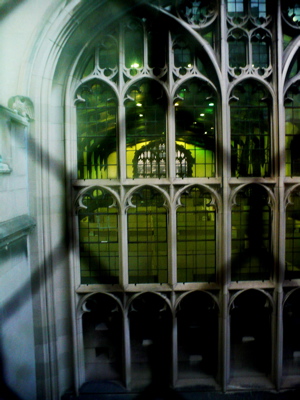Looking out through chicken wire in a high window from a little-used staircase, looking out over a narrow sidewalk several stories below, a tall gothic window faces you, opening out of a distant hall of a little-used library, the window dissecting itself in arch upon arch, pane over pane, in squares set in circles, narrow peaks of masonry, little bits of sky reflected in the top, little shadows set in the bottom.
Inside the window is a large bank of cubicles, just like an office, lit from above by an array of fluorescent lights like the grid dangling over a hockey rink. The ceiling rises high up above the cubicles, supported by rows of pillars and exaggerated wooden beams. At the far end of the room, the north end, there is another gothic window. Perhaps it is the twin of the one we are looking in through.
These monumental windows face almost nothing whatsoever. The south window borders on the glum wall of the Social Sciences Research Building; the north one adjoins the south wall of Rosenwald. They are windows onto walls. They admit light but not sky, shadows but not landscapes.
About a hundred years ago, Thorstein Veblen commented that this architecture was, in a word, phony, being utterly unsuited to modern academic activity, and architecturally jumbled. It “may suggest reflections on the fitness of housing the quest of truth in an edifice of false pretences,” he said grumpily. Here, the gothic windows conceal the cheap monotony of grey cubicles, managing to be impressive from the outside only on the assumption that no one will see the inside.
But is this nothing but a lie built in stone? It strikes me also that this is wasted space, mundane space, lost space, space that doesn’t live up to the fantasy its premises embody, a sort of sad space, where if you showed up with a fairytale fantasy about the life of the mind you would probably be disappointed (unless you gazed out through the gothic windows happily and ignored the fact that there wasn’t much to see through them). Where you hurry to find your book or your desk, huddle together under the fluorescence, dive into your book… if the gothic architecture offers a fantasy experience too unsatisfying to be really livable, does that mean that you are left even more alone to develop your own daydreams about your surroundings? or does academic space just fade into the background, becoming a precondition of work that you come to ignore?
What a dismal allegory for academic life: monumental windows that open onto almost nothing, displaying only an idle group of cubicles for voyeuristic assessment from the back staircase of the next building. If academic life is gothic, does that mean it has both an element of the fantastic and an element of the horrid?
